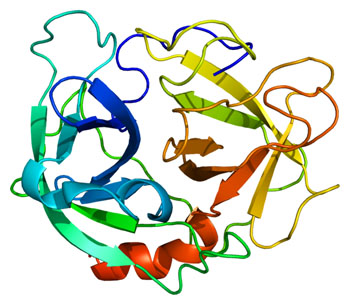Excess Elastase Prevents Muscle Regeneration in Duchenne Muscular Dystrophy
By LabMedica International staff writers
Posted on 14 Jun 2016
Overabundance of the enzyme neutrophil elastase has been linked to the progression of Duchenne muscular dystrophy (DMD) and the inability of patients afflicted with the disorder to repair damaged muscle.Posted on 14 Jun 2016
DMD is caused by mutations in the gene that encodes dystrophin, a protein crucial for maintaining muscle cell integrity and function, and the subsequent disruption of the dystrophin-associated protein complex (DAPC). The mutation occurs on the X-chromosome, and the disease effects about one of every 3,500 boys whose muscle function is so degraded that they die usually before reaching the age of 30. Progressive loss of muscle tissue in DMD is accompanied by fibrosis, chronic inflammation, and reduced muscle regenerative capacity. Although much is known about the development of fibrosis and chronic inflammation in muscular dystrophy, less is known about how they are mechanistically linked to loss of muscle regenerative capacity.

Image: A molecular model of the proteolytic enzyme neutrophil elastase (Photo courtesy of Wikimedia Commons).
Investigators at the University of Liverpool (United Kingdom) developed a proteomics method to discover dystrophy-associated changes in the muscle progenitor cell niche, which identified serine proteases, and especially neutrophil elastase, as candidates. Neutrophil elastase is thought to play a role in degenerative and inflammatory diseases by its proteolysis of collagen-IV and elastin of the extracellular matrix.
The investigators reported in the May 21, 2016, online edition of the journal Scientific Reports that Duchenne-type muscular dystrophy progression in mice was associated with a progressive accumulation of neutrophils and neutrophil-derived elastase. Elastase was toxic to myogenesis leading to decreased myoblast proliferation, increased cell death, and decreased myoblast differentiation, fusion, and myotube growth. Some of these effects were partly dependent on cell adhesion to specific ECM molecules and altogether provided evidence for an additional mechanism through which chronic inflammation and fibrosis might affect DMD pathogenesis.
Senior author Dr. Dada Pisconti, tenure track fellow in biochemistry at the University of Liverpool, said, "Our findings evidence the importance of inflammation in muscular dystrophy and suggest that elevated levels of elastase could play a key role in the progressive muscle degeneration seen in patients affected by DMD. Although there is no cure for muscular dystrophy, improvements in treatments could help control symptoms to improve quality of life. Our next steps are to investigate whether drugs that target elastase are effective and safe as a potential therapy for this disease."
Related Links:
University of Liverpool










 (3) (1).png)


